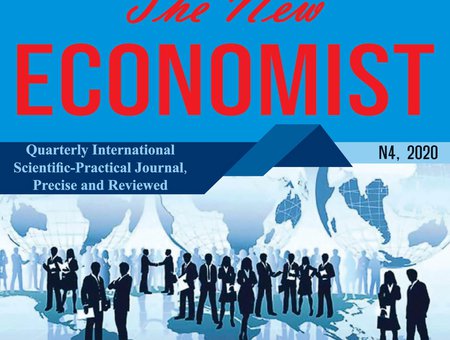Innovative Methods of Personnel Management / პერსონალის მენეჯმენტის ინოვაციური მეთოდები

Mamuka Toria / მამუკა თორია
Doctor of Economic Sciences, Associate Professor, Caucasus International University, / ეკონმოკურ მეცნიერებათა დოქტორი, კავკასიის საერთაშორისო უნივერსიტეტის ასოცირებული პროფესორი.

Lasha Tabatadze
DBA, As.Professor, Ilia State University
Abstract
The article analyzes the fundamental methods of personnel management. The authors points out the leading role of innovative methods of personnel management of a strategic resource in modern conditions of a market economy. Personnel is both a resource and a control element that affects other resources, and with a significant impact on the costs of the enterprise. Moreover, the motivational system of enterprises was considered by a huge number of developers and analysts. But any proposal, implemented in practice, eventually ceases to work as an incentive to constant effective work.
Therefore, the subsystem of incentives for the personnel of the enterprise is one of those where the use of creative management should be mandatory and constant.
The main methods have been proposed for enhancing creativity and searching for innovative ideas among personnel in order to diversify the services of enterprises and increase their competitiveness. Conclusions are presented about the need to move to a new vision of the role of workers in the activities of organizations and search for methods to activate their potential.
Introduction
Introduction
In the era of market relations and the intensification of enterprise development, only those companies that can offer their customers high-quality service can withstand a tough struggle. In turn, the quality of service directly depends on the availability of properly directed and professionally trained personnel. For a modern enterprise manager, the question of finding the most effective methods of personnel management is becoming extremely urgent. Maximizing the use of its potential to ensure the productive operation of the enterprises, increase its competitiveness and profitability. The manager must understand that people who have different abilities, characters and habits work for him. Therefore, he should treat his employees as individuals, and it is these factors that should primarily affect the organization of work of subordinates. Creative management, including personnel management, is considered by most authors as a process of creating conditions for the formation of innovative ideas and developments. And this process today, despite the lack of clear definitions and a formed mechanism, has been studied in a significant volume. At the same time, it is assumed that any element of the control system requires the use of innovative, creative developments. But few people assess where it is most important to apply these solutions. Therefore, we stopped at justifying the need to apply creative management in relation to individual components of management, and especially regarding the personnel management subsystem. As you know, employees are forced to apply creative solutions where standard solutions either do not give the desired effect, or cannot be used at all. The second factor forcing the formation of an unconventional approach to the traditional process is the need to reduce the cost of implementing this very process. When considering the subsystems of the personnel management system, it can be argued that for most enterprises that are in a difficult financial situation, the main reative management application should be focused on staff motivation.
The Creative management.
Today, in the conditions of the decline in the attractiveness of working specialties and the constant growth of the need for them among enterprises and organizations, it becomes necessary to actively use creative proposals in vocational guidance work, as well as planning and marketing of personnel. Without a constant “enticing” advertising policy, most enterprises today will not be able to attract the required number of employees of working specialties (given the not sufficiently high level of wages, public opinion, the lack of skills of most young people for sufficiently hard work and for compliance with a strict regime of work and rest for a long period of time). And, moreover, today it is still difficult to speak about the competition of applicants for these jobs. This creates a high need for a fundamentally new approach to the implementation of the functions of this subsystem of personnel management. [3,2]
The next direction, which requires a non-standard approach to the implementation of the tasks assigned to it, is the formation of corporate culture. It is she who affects the actual content and maintenance at the proper level of labor relations, working conditions, the level of social responsibility of all participants in the labor process in the organization. And the standard, rather formalized approaches to its formation in practice no longer justify themselves. There is a need for creative developments for the introduction of elements of corporate culture into the life of the enterprise in the volume, timing and content that will keep pace with the development of the domestic and global economy and increase the social responsibility of the workforce and each individual employee. The next step, no less important, is the direction of personnel development. And in our society on this issue there are certain trends that slow down the development of enterprises and organizations, the development and implementation of new technical, technological and organizational developments. On se¬godnya staff develops when there are prospects of career ros¬ta, new elements of the labor process implemented (methods, equipment, and so on.). And only a small part develops constantly, regardless of the content of labor, due to the presence of an internal need to acquire new knowledge, skills and abilities. However, given the constant development of science, technology and technology, the world community has recognized the need for the constant development of each member of the team in order to keep pace with the changes being introduced into life. And this requires the management of enterprises and organizations to form such a creative approach to the mechanism of personnel development, which could provide it in a constant mode, in the required direction, with sufficient speed and quality. At the same time, this mechanism should take into account both the capabilities of the enterprise and the capabilities and needs of its employees, in particular the internal motivation and the ability to learn. To achieve all of the above, enterprises and organizations must have employees capable of producing, justifying and implementing creative solutions in the personnel management system. To do this, you need to convert approaches to recruitment and selection of personnel, as standart¬nymi methods of selection is difficult to identify a creative employee, evaluate pozi¬tivnost his work for the company. That is, creative management should be directed to the personnel recruitment subsystem, forming fundamentally new mechanisms for selecting a modern employee.
Despite the fact that the topic of personnel management has been studied quite deeply, there are a number of modern aspects of this direction that have not yet found an effective solution. The conditions of a market economy require a change in the approach to personnel management from understanding it as a functional component of the management and production link of an enterprise. To study and optimize it as a strategic resource with a significant and highly potential, which includes professional competence, the ability to develop creativity and creative ideas. Understanding this poses a challenge for modern managers to search for new methods of personnel management in order to maximize the use of its potential capabilities, creative ideas.
The Classical methods of personnel
management.
The theoretical basis for economic management methods are economic laws. By applying these methods in practice, the manager has the choice to either reward the employee or apply a punishment method. In modern scientific literature, there is an opinion that economic methods should have commodity-money relations of a market economy as their basis. The effectiveness of the application should be assessed by the following parameters: by the form of ownership, by the specifics of doing business, by the type of organizational cultures, by the results of the use of personnel audit, by the tax base system and by the incentive mechanism. Many companies still use material incentives as one of the key methods in personnel management. This enables them to quickly and efficiently improve the quality of their work and achieve the goals and objectives set for the company. But this method also has a “flip side of the coin”.
It consists in the fact that if you use this principle correctly, then the result will not be long in coming, as described above. If misused, this will lead to losses, strikes, overstocking, non-payment, and worse, bankruptcy. Within the framework of administrative methods of management, the head uses his managerial capabilities, applying power relations, a system of administrative and legal penalties, administrative and organizational policies. Administrative methods by their nature encourage staff to understand work discipline, responsibility for the work performed, and a structured activity. Therefore, these methods have a direct impact, since any regulatory and administrative act must be followed. Examples of administrative management practices include prohibition, instruction, order, consultation, business advice, as well as clarification and suggestion.
It is worth noting that with the “negative” impact of these methods, the organization may face the problems of adopting formal collective agreements, using outdated regulations and rules, staff turnover, lack of a control system, and simply indifferent attitude of workers to their work. The purpose of socio-psychological management methods is to understand the laws of the psychological side of people’s activities, in their use and optimization of psychological manifestations in the interests of the company and the individual as a whole. There are two main blocks of methods: by the volume of exposure and by the method of application. The methods are applicable both for large groups of employees and are aimed at the process of interaction in the working environment, and for a specific person in order to influence his inner world. Thus, the leader manages to assess the place and value of the employee in the team, to focus his internal potential on solving specific production problems and to create a favorable socio-psychological climate in the organization.
The Modern management methods and methods of searching for innovative ideas among staff.
Recently, the idea of perceiving personnel as a strategic resource has gained great popularity, especially in the corporate sector. To effectively manage this resource, it is necessary to maximize its apparent and hidden potential. This potential is based not only on professional skills, but also on the ability to be creative, to think creatively and generate new ideas. It is the last components that can become a significant factor in increasing the competitiveness of the enterprise and expanding the segment of potential consumers.
- Participatory style (explain why the employee is important in the team, create a sense of self-worth; applied to new team members and grassroots workers);
- Direct leadership style (answer 5 questions to employees What? How? Why? When? enterprises);
- Teamwork style (exchange of experience, joint problem solving, collective advice: as an example, it is used when organizing banquets and similar events in restaurants);
- «Challenge» - (the manager forms an imaginary problem, and the staff must solve it without any help). According to this method, the leader challenges subordinates, following their subconscious desire to prove their worth to independently solve problems and make decisions;
- «Scamper method» - (solving a problem by replacing, combining, adapting, modifying, applying, eliminating, creating the opposite). The method name includes the first letters of the actions. Which need to be done by personnel over a product, service or a phenomenon in the organization. This will allow you to find many unexpected ideas for modifying existing and creating new products or services;
- «Method of provocations» (search for benefits from unusual, even ridiculous ideas). This method encourages the generation of ideas among staff that transcend standard thinking patterns and are particularly useful. When an enterprise wants to create a completely new product, start a new business;
- «Reframing» (used to solve important business problems). The most common form of reframing is how employees evaluate a problem from the perspective of people in different professions. The manager assigns subordinates to play different roles in critical assessment of various components of the product or service of the enterprise and listens to their opinions, capturing new ideas;
- «Inversion method» (search for rational solutions to the problem when analyzing the opposite problem). According to this method, the leader sets a task for subordinates that is the opposite of the one he wants to solve. As a result, you can get a list of actions and solutions that are not acceptable for a given product or service and use this knowledge to improve them. This method allows workers to see things that they would not notice if the problem was formulated directly. [6,4]
Conclusion
In modern economic conditions, creative management is becoming the norm of management, only its use will allow enterprises and organizations to keep pace with the development of science and technology, the possibility of introducing new mechanisms for managing the team and the production process. Each subsystem, especially the subsystem of personnel management, needs an early transition to creative, non-standard, constantly modernizing management. A variety of methods of personnel management and activation of their innovative potential, on the one hand, gives significant results, and on the other, creates a number of new management problems, due to the fact that they do not provide standard schemes of actions in various situations and a specific binding of each method to situational tasks. A highly qualified manager must be able to choose exactly those methods of searching for innovative ideas that will be most productive in a particular environment and for specific employees. In addition, the end result largely depends on how the managear was able to recognize the overt and hidden abilities of his employees. And gave the opportunity to each of them to take part in innovative activities. So, the modern process of personnel management includes a set of innovative mechanisms organized around the interaction of employees, enhancing the creative potential of personnel, integrating their efforts to achieve the set goals. It is the development of creativity and innovative thinking of the personnel of modern enterprises that can become their key competence and a factor of survival in the competition.
References:
- Teresa M. Amabile, ,,Motivation for Creativity in Organizations” Harvard Business Review Press, 2014;
- Gary Dessler, ,,Human Resource Management”, Fifteenth Edition, 2016;
- Kirsten & Martin Edwards. ,,Predictive HR Analytics: Mastering the HR Metric”, Kogan Page, 2017;
- Karchava, L. and Kutaladze, E., 2020. Tourism as one of the priority directions in Georgia/ტურიზმი როგორც ერთ-ერთი პრიორიტეტული მიმართულება საქართველოში. The New Economist, 15(2, 2020), pp.1-1. http://www.neweconomist.com.ge/journal/article/Tourism-as-one-of-the-priority-directions-in-Georgia-turizmi-rogorc-erT-erTi-prioritetuli-mimarTuleba-sakarTveloSi-1603913380
- Karchava, L., 2014. Again about the investment environment in Georgia Or what kind of investor do we need?/ისევ საინვესტიციო გარემოს შესახებ საქართველოში ანუ როგორი ინვესტორი გვჭირდება?. The New Economist, 9(3, 2014), pp.1-1. http://neweconomist.com.ge/journal/article/Again-about-the-investment-environment-in-Georgia-Or-what-kind-of-investor-do-we-need-1597473717
- Karchava, L., 2018. Theoretical basics of business communication and Its connection with other sciences/ბიზნესკომუნიკაციების თეორიული საფუძვლები და მისი კავშირი სხვა მეცნიერებებთან. The New Economist, 13(3, 2018), pp.1-1. http://neweconomist.com.ge/journal/article/bizneskomunikaciebis-Teoriuli-sapuZvlebi-da-misi-kavSiri-sxva-mecnierebebTan-1594468243 7
- Karchava, L., 2012. Business-communications. Tbilisi, Loi, 328.
- Lomia, E., 2020. „ახალი მსოფლიო წესრიგის “ისტორიული ნარატივები. The New Economist, 15(1, 2020), pp.1-1.
- Lomia, E., 2020. The Evaluation of Russia’s foreign policy towards Georgia following the ‘Rose Revolution’. Journal of Liberty and International affairs, 6(1), pp.112-128.
- Lomia, E., 2017. The United States-Russia Relations Before and After Russia’s Intervention in Georgia and Ukraine.
- Lordkipanidze R. Objective Laws from Wise Competition and Marathon of Life for Strengthen INTERPOL. - By studying of scientific courses at Harvard, St. Petersburg and I. Javakhishvili Tbilisi Universities: 2021: 726. http://dx.doi.org/10.13140/RG.2.2.13704.24320
- Lordkipanidze R. Practical application of my 700 works at the Researchgate http://dx.doi.org/10.13140/RG.2.2.26557.49125
- Lordkipanidze R. For creation (with UN assistance) anti-pandemic and anti-conflict economic zones «Wealth Catalyzing». - Theses on Law, Economic Policy and Money: Issue N3: 2021.
- http://dx.doi.org/10.13140/RG.2.2.28326.96325
- Mgeladze, L., 2020. Future Economy and Georgia/მომავლის ეკონომიკა და საქართველო. The New Economist, 15(2, 2020), pp.1-1.
- Mgeladze, L., 2020. მკვდრადშობილი საჯარო სამსახურის მაკოორდინირებელი ინსტიტუტი. The New Economist, 15(1, 2020), pp.1-1.
- Mgeladze, L., 2019. ეროვნული ვალუტა საქართველოში, ეკონომიკური განვითარების შემაფერხებელი თუ ხელშემწყობი ინსტრუმენტი. The New Economist, 14(2, 2019), pp.1-1.
- Lasha Tabatadze, ,,The New Vision of Modern Management Theory”, The New Economist, No 1-2 (2020), Vol 15, Issue 1;
- Lasha Tabatadze, ,,The Evolution of Management Theories”, The New Economist No 3-4 (2019), Vol 14, Issue 2;
- Mamuka Toria, ,,Human Resource Management”, course of lectures, Tbilisi, ,,Meridiani“, 2014;
- Dave Ulrich, Jon Younger, Wayne Brockbank, Mike Ulrich, ,,HR from the Outside In: Six Competencies for the Future of Human Resources”, Victory Through Organization, 2017;
ანოტაცია
სტატიაში გაანალიზებულია პერსონალის მართვის ფუნდამენტური მეთოდები. ავტორები აღნიშნავენ სტრატეგიული რესურსის - პერსონალის მართვის ინოვაციური მეთოდების წამყვან როლს საბაზრო ეკონომიკის თანამედროვე პირობებში. ადამიანური რესურსი არის ყველაზე ღირებული რესურსი, რომელიც გავლენას ახდენს საწარმოს სხვა რესურსებზე, როგორიცაა საწარმოს ხარჯები. შესაბამისად სულ უფრო მეტად, წინა პლანზე იწევს ადამიანური რესურსების მართვის ინოვაციური მეთოდების მნიშვნელობა. საწარმოთა სამოტივაციო სისტემა განიხილება, როგორც ერთ-ერთი გადამწყვეტი ფაქტორი, დეველოპერებისა და ანალიტიკოსების მხრიდან.
ნაშრომში შემოთავაზებულია პერსონალის კრეატიულობის ამაღლებისა და ინოვაციური იდეების ხელშეწყობის მართვის ძირითადი მეთოდები, რომელიც უზრუნველყოფს საწარმოების კონკურენტუნარიანობის გაზრდას. წარმოდგენილია დასკვნები მომსახურების კომპანიების საქმიანობაში ადამიანური რესურსების მართვის ახალ ხედვებზე გადასვლისა და მათი პოტენციალის გააქტიურების მეთოდების ძიების აუცილებლობის შესახებ.
References
The New Economist N4, (2020), Vol 15, Issue 3

11/01/2021
Copyright (c) 2021 Mamuka Toria / მამუკა თორია, Lasha Tabatadze

This work is licensed under a Creative Commons Attribution-NonCommercial-NoDerivatives 4.0 International License.
